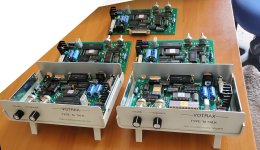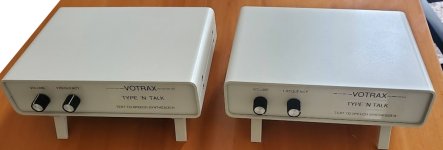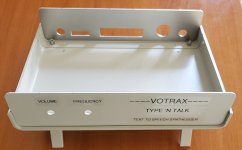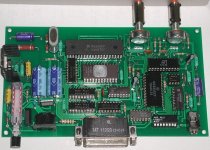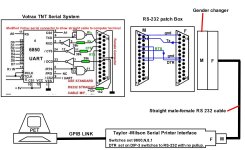Hugo Holden
Veteran Member
I have been building more Votrax Type 'N Talk units. I had enough vintage IC's and ROM's to make 5 units in total.
The thing I like about these is that they are basically an SBC, with 1k of SRAM, a ROM & CPU. They contain all of the sub-systems to safely support and operate the SC-01A speech chip and all they require is a serial input. Quite a few experimenters have used these chips on breadboards, but the risk of damage to them in those experimental lash ups is ever present. This now rare IC is much safer on these boards.
The TNT's board contains an eclectic assortment of oddball parts that it took me some time to hunt down, an unusual long reach DB25 connector, a unique power switch & button, unique speaker connector and axial capacitors, including the green ceramic ones made by the Corning Glass Works. Also the exact large sized original crystal. (modern smaller ones are not as good). I also used vintage NOS 7805 and 7812 regulators with the thick metal tabs. I made the replicas as accurately as possible in every respect. Though I had the sense to place some pcb switches as solder links to make them work with either the 2732 or the 2532 ROMS. I only had just enough ROMs (some of my stock turned out to be fakes). I'm still waiting on some 3.5mm connectors for the speaker because I used the remaining ones I had of these in my SOL-20, they are the same part.The board assembly is quite time consuming. The potentiometer I used were made by Alpha and because the case was a little deeper than the original TNT case, these required shaft extensions.
I had all of the vintage 74 series chips in my own stock except one I ran out of , the 7442 now on order. The CPU in these is the 6802 and the UART is the 6850.
I fitted one unit with a NOS pink ceramic Gold top 1980 vintage 6802 CPU, Also a pink ceramic Gold top UART.
I only had two Takachi extruded aluminium housings with the Tilt Feet option, so currently 3 boards do not have a housing. Takachi will also supply their housings with the panels CNC machined, but for these one I cut the holes out by hand which is a fairly long process to get them looking like a machine did it and have no makings on the panel surfaces.
My plan now is to team the Votrax unit/s up with my PET, using the Taylor Wilson GBIP to serial printer interface that I restored in the recent past. The TNT's can be daisy chained and selected with a control code, so I might be able to get my PET to have a conversation with itself, which could be amusing, especially if combined with some simple graphics.
The thing I like about these is that they are basically an SBC, with 1k of SRAM, a ROM & CPU. They contain all of the sub-systems to safely support and operate the SC-01A speech chip and all they require is a serial input. Quite a few experimenters have used these chips on breadboards, but the risk of damage to them in those experimental lash ups is ever present. This now rare IC is much safer on these boards.
The TNT's board contains an eclectic assortment of oddball parts that it took me some time to hunt down, an unusual long reach DB25 connector, a unique power switch & button, unique speaker connector and axial capacitors, including the green ceramic ones made by the Corning Glass Works. Also the exact large sized original crystal. (modern smaller ones are not as good). I also used vintage NOS 7805 and 7812 regulators with the thick metal tabs. I made the replicas as accurately as possible in every respect. Though I had the sense to place some pcb switches as solder links to make them work with either the 2732 or the 2532 ROMS. I only had just enough ROMs (some of my stock turned out to be fakes). I'm still waiting on some 3.5mm connectors for the speaker because I used the remaining ones I had of these in my SOL-20, they are the same part.The board assembly is quite time consuming. The potentiometer I used were made by Alpha and because the case was a little deeper than the original TNT case, these required shaft extensions.
I had all of the vintage 74 series chips in my own stock except one I ran out of , the 7442 now on order. The CPU in these is the 6802 and the UART is the 6850.
I fitted one unit with a NOS pink ceramic Gold top 1980 vintage 6802 CPU, Also a pink ceramic Gold top UART.
I only had two Takachi extruded aluminium housings with the Tilt Feet option, so currently 3 boards do not have a housing. Takachi will also supply their housings with the panels CNC machined, but for these one I cut the holes out by hand which is a fairly long process to get them looking like a machine did it and have no makings on the panel surfaces.
My plan now is to team the Votrax unit/s up with my PET, using the Taylor Wilson GBIP to serial printer interface that I restored in the recent past. The TNT's can be daisy chained and selected with a control code, so I might be able to get my PET to have a conversation with itself, which could be amusing, especially if combined with some simple graphics.

